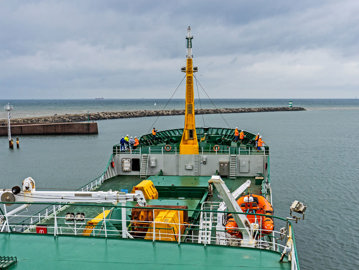
Responsible fishing
We, at Cornelis Vrolijk, are constantly thinking about how we can catch our fish in a more sustainable way. Not just for today, but also for tomorrow and the more distant future.
Sustainable fishing is vital
As we want to continue our fishing operations in the long term, corporate social responsibility is part of our everyday work.
Running a sustainable business includes adjusting to natural conditions. Nature constantly changes and it is up to us to adapt to its dynamics. In order to do our work as sustainably as possible, we contribute to scientific research into fish and fish stocks. This research provides science and politics with insights to determine quotas responsibly. Compliance with the quota determination and with other regulations is essential to be able to work sustainably.
Our contribution to responsible fishing
We at Cornelis Vrolijk want to give future generations the chance to continue to fish. That's why one of our main objectives is to contribute to research on the fish stocks. This makes it possible to determine the maximum sustainable catch per fish species. Would you like to know more?

EU fisheries policy
The EU fisheries policy can be found in the Common Fisheries Policy (CFP). The main objective is to create a sustainable fishing industry and to guarantee stable incomes and employment for fishermen. Since the reform of the CFP in 2002, and now that the quotas are set more in line with scientific recommendations, overfishing has been strongly reduced in Europe, and many fish stocks have recovered.

How fishing quotas are set
In the fishing industry, the concept of Maximum Sustainable Yield (MSY) is used to determine safe and healthy stock sizes. The MSY also provides insights into the annual amount of fish that can be caught sustainably. As an average, this means no more than the quantity by which the fish population grows naturally. In this way, the fishing industry can continue to operate for a long time to come without damaging the fish stock.
Policy makers need stock estimates to be able to determine how much fish of a certain species can be caught in any given year. They also evaluate the stock management conducted. Based on stock estimates, the International Council for the Exploration of the Sea (ICES) issues annual catch advice for 200 fish species.
Based on the MSY, the total allowable catch (TAC) is determined each year. TACs are divided among EU countries based on national quotas. That way, we know the maximum annual amount that we can catch.
To that end, the European Commission has set up several advisory councils. In these councils, various stakeholders meet to issue joint advice. The fishing industry, NGOs and other stakeholders are represented in the councils. They issue their advice to European institutions that decide on quotas and other fishing regulations.

Monitoring and compliance
We do not catch more fish than our allocated quota per species. This is very closely monitored by governments. During a fishing trip, skippers report the catch processed through electronic logs every 24 hours. Furthermore, all our vessels are fitted with Vessel Monitoring Systems (VMS), so that governments and scientific bodies can verify the locations of our vessels via a satellite link at all times. Inspection vessels from coastal states regularly carry out surprise inspections at sea.
After each fishing trip, the quantity of fish unloaded in port is accurately registered. The Dutch Food and Consumer Product Safety Authority (NVWA) conducts inspections to check this. Throughout the year, the producers organisation keeps a close eye on the use and availability of quotas at national level in cooperation with the Ministry of Agriculture, Nature and Food Quality. This way, the quotas set are not exceeded accidentally.
In addition to quotas and inspections, there are many technical measures to be complied with by the fishing industry. Examples are rules about fishing areas or nets. National and European institutions have compiled a comprehensive set of laws and regulations. Of course, sustainable fishing means that we comply with all those rules. Only then can we remain fishermen of tomorrow.
